You are currently browsing the market crash category
First, the plug:
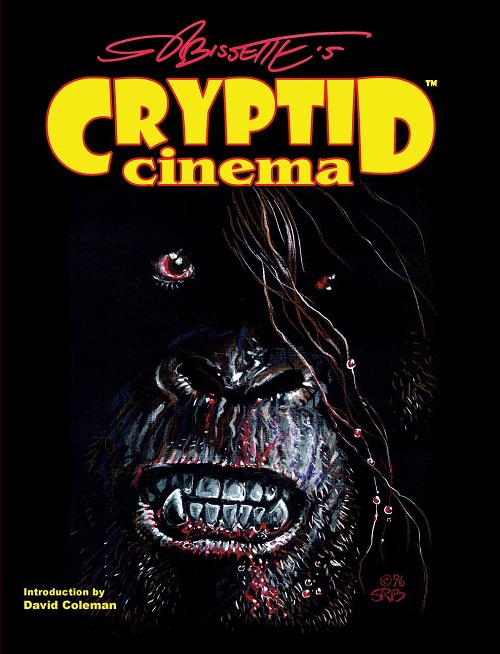
Steve Bissette (whom you may remember having drawn a certain swamp monster of some note) has published a new book, Cryptid Cinema, where he discusses a few of his favorite movie critters. Along the way of the production of this volume, Mr. Bissette asked for my assistance, particularly regarding some of the goofy Swamp Thing merchandise that was produced way back when. Well, specifically, he asked if he could quote some of my old blog posts on the topic, to which I of course said “sure!” So here we are, a big ol’ book by ME ME ME with some help from Steve Bissette that you can order just by clicking on this little box here:
Tell ’em Mike sent you! And when they say “
who?” just turn around and run,
run like the dickens.
And of course, a big, big thanks to Mr. Bissette for asking me to be involved!
• • •
Okay, now back to Progressive Ruin, which is already in progress:
Dan wonders in the comments to Monday’s post:
“I was never able to find out what exactly ‘Mando’ or ‘Baxter’ paper is besides ‘a kind of paper they printed comics on.’ Are they brand names? Named after inventors? What other uses do the have? Newsprint I get – it’s what they print newspapers on.”
I…don’t know. I just assumed they were names assigned to various kinds of paper stock by the manufacturers. Just doing a quick Googling I found a couple of references to “MANDO paper,” as in the “Minnesota and Ontario Paper Company. I didn’t find many specific references to this being the same mando paper stock as used in comics, outside a message board entry or two, but maybe someone who knows better can clear it up.
Baxter paper I’m not so sure about…there are some references to a couple of paper companies with “Baxter” in their name, including, confusingly enough, a fictional Leland Baxter Paper Company that supposedly constructed the Fantastic Four’s Baxter Building. I’m pretty sure that, like I said, it was just a name assigned by the manufacturer to its product, and again, if anyone has a more specific answer, please chime in!
EDIT: Thom H. notes in the comments that Baxter paper appears to have originated from the Great Northern Paper Company (which was one of the possible sources I turned up in my own search). Ben backs this up in the comments to my Monday post, and both fellas point to this weblog posting and comments for sourcing.
From Wednesday’s post, James G. asks
I got out of comics for a while, and was pulled back in by Transmetropolitan, which is a pretty awesome way to get back into the medium. So there is a bunch of stuff that you mention (Deathwatch 2000, X-Men #1) that I don’t even know what that means, or what it’s implications to the direct market, retail system, etc were. I don’t even know what a Deathmate is, unless it’s an ex-GF (buddum-chihhh, I’ll be here all week). Can you elaborate a little, or is there somewhere (other than googling that for me) that you could recommend?
James, I apologize. I’ve been doing this so long (I mean, selling comics, not just blogging about them, though that’s likely the case as well) that I just throw out references here and there and everywhere and assume that just because I know what I’m talking about, that everyone else will too. I do attempt explanations when I can, but some events just loom so large for me in my recollections of the Comics of Decades Past, I forget not everyone was there experiencing the same magical times that I was.
The big deal with X-Men #1 was that there were five variant covers for the issue (which you can see right here, with the newsstand edition included as well), with each cover released in subsequent weeks. The first four covers formed a larger image, and the fifth variant featured all four covers linked together in a wraparound foldout cover. This came out around the peak of the comic market boom, and orders on these comics were out of control. I think the combined total made this the highest ordered comic at least in the modern age, or maybe even since the Golden Age…trying to look this up to confirm just brought me to a bunch of comic book “investment” sites, which depressed me, but trust me…there’s a lot of copies of this.
Now, don’t get me wrong…the comic sold great. We sold a ton of them at the time. Hell, even I bought one. (Just one!) But we had a bunch left over as well, as at the time the store purchasing strategy was “this is the first issue of a new ongoing X-Men series, the first since the Silver Age, better have lots on hand for all that back issue demand!” I’ve joked that even since opening my own shop, I’ve acquired a small backlog of some of these first issues without even really trying to buy any, and by “joked” I mean “accurately described my specific experience.” They just kinda…show up, man. They do still sell even now, on occasion. Of course, even given the large amounts of copies that were printed, perhaps copies are not as easy to track down now, given that many stores at the time that may have had overstock are now gone, and that a significant percentage of people who bought it at the time either lost them or didn’t store them properly. This is something I discussed a while back, if you’re interested.
Deathmate was the greatly-anticipated crossover between the then new and hot publishers Image Comics and Valiant Comics. I actually did a write-up on this, oh, about 12 years ago, which is good because I could barely remember the “story” details now. Anyway everyone overordered it, it had problems with shipping delays, I think some people were put out that Spawn wasn’t involved (or only just barely) and it turned into a huge backroom burden because it didn’t sell anywhere close to expectations. As noted in that post I linked, I was happy to rid myself of these for the princely sum of one slim nickel each, and good riddance.
“Deathwatch 2000” (boy, comics were big on death then, you know, not like now) was the big crossover event from Continuity Comics. Continuity was the company run by legendary comics artist Neal Adams, with most of the titles seemingly drawn by him or at least drawn in his house style. They had bit of a following…in particular Armor, Samuree and Megalith seemed to be the most popular. Now, here’s where things get a bit fuzzy, as I don’t remember the specifics, but I seem to recall some kind of special “#0” issue that was part of the storyline but wasn’t, like, sold on the stands. Specifically, there were some hoops for readers to jump through in order to “qualify” for getting that issue…honestly, I just can’t recall what it was. I just remember we had too many of that comic. (And no, I’m not talking about the Valeria the She-Bat comics Continuity released as yet another hard-to-get premium comic, the details for which I also can’t recollect.) Hopefully, as I plow through those boxes of old promotional material from the previous place of employment, I’ll be able to glean some clues as to what specifically was going on.
Zoot Koomie zoots
I had completely forgotten about Continuity Comics. If you’re looking for content to write about, I’d be interested in a retrospective.
As you see just above, my memories of Continuity are pretty limited. I didn’t read any at the time (though I was tempted by Echo of Futurepast, their anthology comic). I’ll see if I can come up with anything more.
I was buying lots of Dark Horse, First, and Eclipse books at the time and still didn’t recognize most of their titles when I looked them up just now. How did they sell compared to the other small publishers?
Pretty well, actually. There were the Big Two (National Periodical and Timely Comics) and then there were the larger small-press companies (the three you mention, plus probably a couple of others), the not-quite-as-big-as-the-bigger-smaller-publishers (companies like maybe Fantagraphics and, yes, Continuity), and then the small-small publishers, who did their one or two titles every few months and that was that. Of course, that’s just talking about periodicals…once you factor in Fantagraphics’ book publishing, that boosts them up a bit. And plus, I’m just going on personal experience…maybe there were stores where, say, Jon Sable Freelance outsold X-Men. Hey, it could happen.
I sort of touch on this topic in this post, where I mention that it was kind of a different comics market back then, with people more willing to try books from indie publishers. Sales on what probably look like strange, offbeat books to current eyes likely sold better than you’d expect. Probably at numbers that Marvel and DC would love to have now.
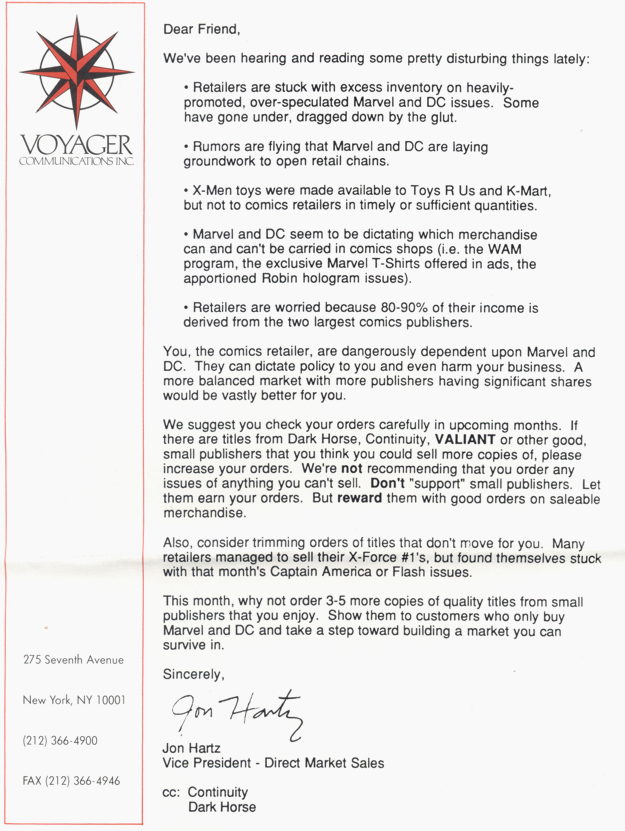
Here’s an interesting artifact of the early ’90s comics market boom/bust…a letter from Voyager Communications (the publisher of Valiant Comics) encouraging retailers to lessen their dependence on the Big Two companies and be more open to upping orders on indies (like, oh, say, Valiant Comics). I like the list of then-current perceived problems in the direct market at the beginning of the letter. I vaguely remember the Marvel/DC retail chain thing. I don’t remember there being any distribution/”apportioning” problems with the Robin hologram covers…I just remember there were too many of them! And toys…man, toys are still a weird thing for comics shops to deal with, given that on some items it’s way too hard to compete with chain stores re: wholesale pricing and release dates.
The advice in this letter isn’t bad, by any means…a more diverse product line is usually a healthier option. And “consider trimming orders of titles that don’t sell for you” may seem like “no duh” advice, but trust me, that wasn’t happening as often as it should. Plus, by the time this letter got around (late 1991, I think, given the letter was with a Shadowman #1 promo), it may have been too little, too late for some shops. There were more excesses yet to come, with the Death (and Return) of Superman right around the corner, and I think X-Men #1 may have been happening about the time of this letter, and we still had Image Comics on its way, not to mention a certain title mentioned in the very subject line of this post. Money was being made, yes, at least for a time, but too much unsold stock was piling up as well, and when that crash hit, those high orders would kill you. (Wrote a bit about that a couple of months ago.)
I see also that Dark Horse Comics and Continuity Comics were cc-ed this particular memo, presumably to…I don’t know, get them to chime in or something. They had their own then-forthcoming attempts at seizing market share that may have helped spread some retailers thin…”Comics’ Greatest World,” one of too many new “universes” companies were trying to get off the ground, or Valeria the She-Bat, which required some hoop-jumping in order to get the early (and as it turned out, almost the only) issues of the series. And there were some kind of shenanigans with the “Deathwatch 2000” crossover that I barely recall now, but just remember it was a pain in the butt and it turned out nobody cared anyway.
And I won’t even mention Deathmate. Well, except right then.
Basically, there’s a lot of blame to share in the 1990s market crash. It ain’t just on Marvel and DC’s shoulders, and some bad choices by some retailers themselves didn’t help either.
Anyway, thank goodness weird publishing initiatives like that are all behind us now! Just smooth sailing ahead for the comics industry!
Okay, still trying to extract some old Batman ’89/early comics retailing memories from my head to supplement the last couple of posts. A few of you have contributed your own memories, and I shall be commenting upon them soon, oh yes, so prepare yourself for that.
As it turned out, I was talking to my old boss Ralph the other day and pestered him a bit about the impact the first Tim Burton Batman movie had on the shop. In line with what I told you the other day, Ralph said that business had pretty much exploded what with all the excitement over the film’s release, and while lots of different things were doing well, Batman comics and merchandise were of course doing the best. One thing he mentioned that I should have remembered was what happened to prices on the 1970s Joker series, which suddenly skyrocketed. Prior to this period of time, you could get them dirt cheap…I’d bought a copy of #1 for one slim dime at a comic book convention, and Ralph had issues scattered throughout his 50-cent bargain bins. Ralph recalled that when the Bat-craze hit, and prices shot up, he dug through the bargain bins to pull out all those Joker comics. Of course, one or two got missed, and Ralph would just have to cringe inwardly as he sold the $20 comic (or whatever it was) for four bits.
On a related note, I had asked Ralph what his invoices were like at the time…I had vague memories, but wanted some confirmation. Ralph said that during the boom years, the weekly comics invoice would easily reach several thousand dollars, at a time when DC and Marvel comic book prices were still, what, about $1.50 each, and indies were $2 to $3? Ralph said he was ordering hundreds of copies of several books and mostly selling through on them…and the back issue market was still strong enough that we were selling a lot of back-numbered comics as well. So basically money was just pouring in the door, to the extent that Ralph had bought a new truck about that time and paid for it entirely in cash. That’s the sort of thing that would probably set off alarms today, but back then, in the wild and crazy days of the late ’80s/early ’90s, ’twas no big deal.
As I’ve said in the past, when the crash came, it came quick, and we didn’t know it was a crash at the time. We figured it was a brief lull in sales, and that folks would be back, and orders continued to be placed as if sales would be back up shortly…and it eventually became fairly evident that wasn’t happening. For business to go from doing so well to [crickets] was a shock, and the store had nearly died before orders could be adjusted back to realistic levels. One specific example Ralph gave (and gave me permission to relate here) was having a new comics invoice that cost about $12,000, and then making only about $7,000 for that week. As you can imagine, having too many weeks like that could drive any business into the ground…and it did, for many comic shops at the time. We were able to ride it out, once we scaled orders back, and plus we had game products in the store that supplemented our income, and we were still the biggest comic shop in the area, so we still did some comics business. Oh, and pogs helped too. No, really.
It was a strange time to live through, and one that I hopefully learned from as I run my own store now (he said, juggling numbers to get those Marvel lenticular covers). Anyway, next time I’ll talk more Batman ’89 and less “I SURVIVED THE ’90s COMICS CRASH AND ALL I GOT WAS THIS FOIL-LOGOED SHADOWHAWK T-SHIRT.” If you have your own Batman ’89 memories, feel free to chip in!
Brandon submits
“You probably covered this, but can you think of a time in early Mike’s comics retail career where something came up that completely junked how you thought comics should be ordered?”
I think I follow what you’re saying here, but let me give a couple of different answers to you.
One of the first lessons I learned from my old boss Ralph is “order with your head, not your heart.” And before anyone pipes up, that’s not a 100%, completely binary thing, by any means…yes, sometimes you order with your heart, because there are comics and characters and creators you like and want to support and of course you think investing your time and money in them is a good idea. I mean, we’re not machines, we all have our preferences and that informs our decisions. The trick is not to be stupid about it.
If you’re supporting a comic you like, which, oh, let’s say it’s Our Swamp Thing at War, and you’re ordering piles and piles of it, thinking “well, if I love it, surely all of my customers will love it, too!” Then, after a few months of not selling any, you’re still thinking “it’s gonna catch on, I just know it” — well, sooner or later your head is going to have to pull rank on your heart and cut those orders down to what you’re really selling versus what you think they should sell.
This is probably a “no-duh” kind of realization…I’m pretty sure I didn’t go into this thinking that it was all “la de dah, just get whatever” and throwing down whatever numbers you wanted on the order form. But I think I was surprised by the amount of number-crunching involved in actually ordering comics, with looking back at the sales histories of individual titles, at seasonal changes, at what creator or character’s presence in a particular issue might do its sales, etc. And sometimes this decision-making is crazily exact…I have, well, not agonized exactly, that’s too strong a word, but I’ve definitely waffled over the difference of a single unit on a comic for a longer period of time than I really should have. Like, maybe 20 copies feels like it’s too many, but dropping it down to 19 just doesn’t seem like that would be enough. No, I’m not exaggerating.
So maybe that’s the actual response in this first part of this answer: that I wasn’t aware at first of just how much work actually went into placing orders. I’m not sure what I pictured, but it was probably a lot more casual than the advanced calculus I’ve since ended up doing to figure out how many Marvel variant covers I can order.
The second part of my answer is more involved with the overall health of the marketplace. I am sure I’ve mentioned once or thrice over the years about the sudden seachange I experienced during the boom ‘n’ crash period of the early 1990s, when the latest Diamond Previews arrived, cover-featuring Dark Horse’s new superhero imprint “Comics’ Greatest World.” My memory is a little fuzzy on the details, but my recollection is that there were either multiple superhero universes launching in that same Previews, or that I realized just how many superhero universes were being thrust upon the stands. I do remember thinking “where are the customers to support all these new ‘universes’ going to come from?” and, perhaps on a more selfish level, “how are we going to have room on our shelves for all these different comics?” Now, as it turned out, the marketplace eventually took care of this problem for us, but that was still a bit of an alarming realization.
Now keep in mind the big comics boom was still in progress of becoming a crash around this period, so we had been more-or-less accustomed to (or perhaps spoiled by) the idea that there were plenty of folks in the marketplace ready to support nearly anything that was published. There was of course no shortage of clues that the market was sick…the prevalence of investors, the proliferation of gimmicks and enhanced covers…but for some reason, seeing that particular issue of Previews, with the promise of More of the Same Kind of Stuff Coming on Top of the Stuff That’s Already Here, was the literal final straw. The sorta vague feeling that things weren’t healthy, the one you could ignore because hey, look at all this money we’re making, now came into tighter focus. To try to bring it back to your original question, Brandon, is that this was the transition from “order lots because comics will always sell great forever” to “order what’s going to sell now, and be more picky about what you want left over for backstock.” Not the catchiest way of putting it, I suppose, but true just the same.
• • •
Oh, hey, over at Trouble with Comics, to make up for all of us hatin’ on Jack Kirby in our younger years, we pick out
our favorite obscure Kirby works.
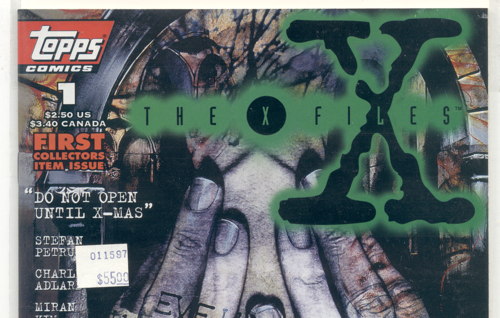
So when Topps Comics released
The X-Files #1 in the mid-1990s, about a year or so after the TV show’s debut, the demand for the comic caught us a bit by surprise. We ordered what we thought was a good number, considering the industry was well into its market crash at this point, but this was one of those comics that caught folks by surprise by managing to bring non-comic readers into shops. We sold out in short order, and proceeded to field requests the rest of the week from people looking for copies of that first issue, while thinking the whole time “if only we knew” which you can never really know for certain, really.
The upshot of all this is that X-Files became a “hot” item in a business where “hot” items were a pretty significant factor in almost destroying said business just a year or two earlier. And you can see a good example of just how “hot” it was if you cast your peepers back to the scan above and the price sticker visible therein.
That issue was among the many, many comics that came with this collection, and was one of the books that survived the sorting process as I worked through the boxes, throwing some into the bargain boxes and keeping some aside for potential use in the regular stock, or on the eBay. I haven’t dealt much with the old Topps run of X-Files…people poke through its slot in the back issue boxes once in a while, but it’s not like I’ve had a lot of demand of the series lately, even with a new series being released from IDW. At any rate, I’ve not really thought about the prices on this series in some time, and spotting the #1 in this collection, I pulled it aside thinking it was, if no longer at the $55 price it had been marked, surely it was probably still worth something.
Well, nope, not really.
A quick search of the eBay shows lots of the first three, four or five issues (including the first printing of #1, like the one I have from that collection) usually only sell for about five to ten bucks. The #1 by itself sold for as cheaply as $2, and I found one that sold for nearly eight bucks, which is more the exception than the rule, it seems. (A “slabbed” copy of #1, signed the stars of the TV series, sold for about $400, so I guess there’s that.) There are copies currently listed in the $10 – $15 range, but unless someone’s desperate to get a copy, they’re probably not going anywhere fast.
And I didn’t go back to double-check, because I’ve looked at eBay enough today, but my impression was that there were many attempts to sell the serial-numbered second printings as some kind of special big-deal thing, but no one cares too much about those, either.
The “too long, didn’t read” version: some formerly-hot comics don’t sell for what they used to anymore, which I’m sure comes as a surprise to everyone. And yet, even with this knowledge, I still don’t want to just dump this comic in the bargain bin. The days of getting $55 for this comic are long gone, but I might be able to get $5, maybe, if I’m lucky.
• • •
In other news:
- The other day, when I mentioned how I thought a new Legion of Super-Heroes series would be best served by making the focus one character, with the rest of the cast as occasional supporting characters? Jer asked which one, and Casey in the comments suggested “Brainiac 5,” which actually was my suggestion, too, when I previously brought up the topic.
Still think that’s a good idea. The team book version of Legion is not one people seem to want anymore, or at least no one’s hit on a version of the Legion that really does anything for anybody. There’s going to be another Legion book sooner or later, and it can’t hurt to try something different…I mean, what, you might end up with another dead Legion book if the idea doesn’t pan out? Or maybe you might have something that has a little staying power? What’s to lose, really? Other than money, creative efforts, market value of a DC property which has been adversely affected by yet another cancellation, so on?
- Back to that collection: Wayne asks if we have to inventory all the toys that came with this collection. In this case…no, not really. Our perusal of the toys, an informal inventory, revealed a handful of figures sans accessories that we might be able to sell for a couple of bucks each. Haven’t really made the time or space to price these things up and put ’em out for sale…they’re low cost, low priority items, which we got essentially for free, and we haven’t really dealt with them yet because there are always other things occupying our time at the shop. The investment in this collection, aside from employee costs in processing and space taken up by storing the boxes, is minimal.
Having looked more closely at the toys, we’ll probably keep a handful of the usable stuff and dump the rest, either in the trash or in an eBay auction titled “BIG BOX OF CRAP – cheap! L@@K H@T” just to get it all out of my hair. Even the box of little accessories probably isn’t worth the trouble or mess, and may go on the eBay too. Someday. When I have the time.
- Pal Dave is starting a new feature on his site: “I Had That!” Nostalgia ahoy from one of the best comic/pop culture bloggers out there.
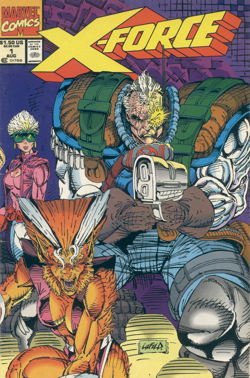 It seems really almost like yesterday I was setting up a table near the front of the store to show off all the editions of the brand-new X-Force #1, drawn by red-hot young artist Rob Liefeld. Each factory-sealed in polybags with one of five different trading cards, stacked up high and waiting for us to open our doors for that new comics day.
It seems really almost like yesterday I was setting up a table near the front of the store to show off all the editions of the brand-new X-Force #1, drawn by red-hot young artist Rob Liefeld. Each factory-sealed in polybags with one of five different trading cards, stacked up high and waiting for us to open our doors for that new comics day.
And did they sell? Oh Lordy, did they ever. It was 1991, the Good Old Days of Comics Retail, and anything that even just slightly smelled of being Hot and Collectible was in high demand. As I recall, a number of our copies of X-Force #1 shared a particular printing defect, a thin dark line that stretched down the front cover, painfully obvious and not obscured at all by the polybag covering. We pulled these aside for replacement from the distributor, but again, as memory serves, such was the demand for the comic that we were even able to sell copies of these, perhaps under the customers’ assumption that the comic’s presence within that sealed polybag thus ensured it was mint, regardless of the item’s actual condition. We noted the damage, we may even have dropped the price a bit to account for the flaw, but still they sold.
And everyone bought them. Yes, everyone. I bought one. I admit it. I was caught up in the hype and the craziness and it’s not like this was the only time I apparently overlooked any kind of deficiency in storytelling in my funnybooks.
If you were around buying comics in 1991, you probably bought one too. You may have bought one of each, to get all the trading cards. …Hey, I’m not judging. It was a weird time, and a lot of us conspicuously consumed a lot more comics-related product than was probably healthy. I’m sure most of us have full sets of the first series of Marvel Universe trading cards, too. (Judging by the number of people who try to sell these sets back to us now, I suspect Marvel went door to door and gave a set to every U.S. citizen.)
Anyway, we sold a lot of X-Force #1s. I’m sure a good number of them went into the hands of kids and teens who dived into the comics collecting hobby during its peak faddish phase, who dived right back out again as soon as that fad was over. I didn’t sell any full cases of them to single buyers, but I’m sure they did somewhere. They sold and they sold and they sold, and sales on the book continued to be strong, as both current issues on the rack and from the back issue bins, and so it went until the comics market crashed a couple of years later, and well, you can read more about that if you’d like.
X-Force continued with mostly reasonable sales, relatively speaking given the state of the marketplace, ’til it finally wrapped up in the early 2000s after a dramatic revamping of the book (and restarting as X-Statix). It’s had the occasional relaunch since then, selling on a much, much smaller scale (just like everything else in the comics market nowadays, compared the land of good ‘n’ plenty back in the early ’90s). Unsurprisingly, back issue demand has dropped, and most people who were interested in those early issues likely bought them as they were coming out. Plus, tastes have changed…what was “hot” and seemingly cutting edge in 1991 is now dated, its shortcomings more obvious now that we have the perspective of distance.
I was looking at eBay the other day, specifically looking at entries for sold items featuring Deadpool. Deadpool, who had debuted in New Mutants #98, just prior to that title being retooled into X-Force, who has been experiencing something of a renaissance over the last couple of years in a handful of popular series. Of late, I’ve noticed that sales haven’t been quite as strong for us on the various Deadpool projects that have reached the stands. The trade paperback collections still move quite well, but the bloom appears off the rose for the actual periodicals. A temporary dip? Burnout from overexposure? Anticipation dying down from a supposed movie that never materialized? Who knows, really, but it’s a trend I’ll need to keep an eye on.
However, back to the eBay. I saw some eBay sellers trying to move those early issues of X-Force with liberal application of “DEADPOOL! H@T! L@@K!” shouting from the auction titles, a desperate marketing move to rid themselves of stagnant product, not too dissimilar from using the “Copper Age” label to get folks to oh God please buy some of these copies of Arak Son of Thunder. In particular, I saw one or two instances of X-Force #1 being sold with a “DEADPOOL!” notice in the title, and I, a proud owner of X-Force #1 as I have explained previously, could not recall Mr. Pool’s presence in said comic, beyond being on one of the prepacked trading cards.
Turns out, sure enough, there he is, in one of the Cable Guide files that filled some space not taken up by house ads in the back:
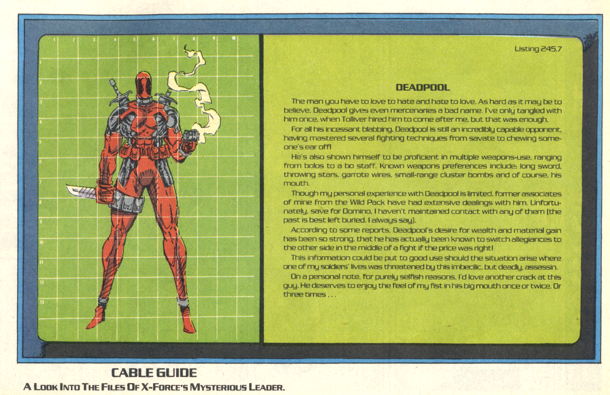
This does not appear to be a sales incentive, it seems. Even
X-Force #2, plugged by many sellers as featuring Deadpool’s second (in-story, as opposed to trading card or Cable Guide page) appearance, doesn’t appear to be gaining any sales traction. That these comics originally sold in quantities probably far in excess of the actual number of comic collectors still remaining in the marketplace is the main reason. In fact, I suspect there’s some kind of economic concept regarding the supply of things and potential demand for them that covers the situation quite nicely. (On the other hand, the aforementioned
New Mutants #98, which sold okay back in the day but not
nearly close to
X-Force numbers, currently sells for big money whenever you can dig one up.)
That’s not to say X-Force is now entirely unsellable. I’ve sold some of those early issues. There are still fans of that type of work. But it’s a weird sort of nostalgia that I get when I deal with these comics now, a reminder of a time when it seemed like the industry, the publishing industry itself, not the media adaptations, was an unstoppable juggernaut, an unending tidal wave of new comics and new relaunches and new #1s and Big Name Artists and new superhero universes and that we couldn’t see the bare ocean floor that wave was going to leave in its wake.
While the Valiant Comics collectability heyday of the 1990s is now a distant memory, along with most collectability of ’90s comics for that matter, there still remains some market desirability for certain Valiant releases: the early “pre-Unity” issues (Unity being Valiant’s line-wide crossover event series), the last issues of some of their series (with their smaller print runs, you see), the early video game comics (Captain N, Super Mario Bros.), some of the #0s and mail-away/promo books, and the gold logo/gold foil variants of some of their regular issues.
Now, it’s been a long time since I’ve thought about how these gold variants were distributed to retailers…I don’t think it was like how variants are doled out by the big publishers today, where you get one special variant for every 10, 25, 100, whatever regular covers you ordered. I suspect, at least in some cases, that the gold editions were just mailed out to retailers for us to do with as we wish. In any case, in recent years these gold variants have been selling for a pretty penny on the eBay, and the few we’ve acquired in collections over the last few years turned over some sizable profit via the online auctions.
However, I suspect we may experience where the line is drawn vis-à-vis Valiant gold-logo collectability with this recently-acquired golden edition:
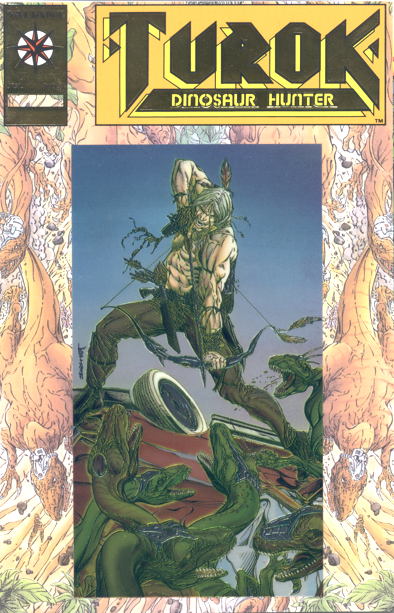
It’s probably a bit hard to tell, but that’s a gold corner box
and a gold foil logo on that
Turok #1. Now, as
I’ve written before,
Turok #1 was, if not a cause, at least one of the primary symptoms of the ’90s market crash. Hot collectable company produces what should be a hot collectable #1, every retailer on the planet orders a
royal assload of said #1, #1 comes out, nobody cares. So all those retailers end up with a huge ol’ turkey that they try to blow out in their bargain bins in the subsequent decade or two since.
Now, it’s possible that someday we’ll experience the Shazam! effect, where the greatly-anticipated release of Shazam! #1 in 1973 resulted in a huge abundance of that comic in the marketplace, with many copies going straight to quarter boxes. There they sat, thumbed over and exposed to the elements, until suddenly…oh, hey, it’s awfully hard to find mint copies of that comic nowadays, and now price guides have mint copies of Shazam #1 at, I don’t know, $40, $60 maybe? I don’t have my guide in front of me, but you get the idea. But if that happens to Turok #1, ever, it may not be until after I’m long dead, so, you know, in ten years or so. But basically what I’m saying is that Turok #1 is not seen as a desirable collectable by pretty much anyone, and I suspect even having a gold logo may not make that much of a difference. This site, which has been monitoring online Valiant sales, notes the market value at about $12, but ain’t too bad, I guess, but not really a patch on some of the money we’ve made on other gold Valiant variants.
But still, that gold edition Turok is nice-looking. And I do like Turok comics. Maybe I’ll just keep it.
Speaking of gold editions…this strictly isn’t just a variant, as such:
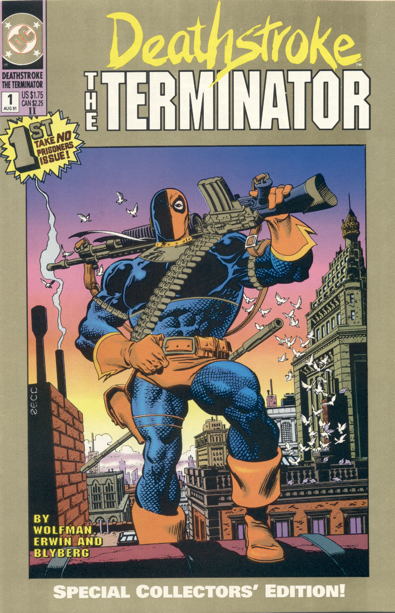
…but a second printing, which DC indicated by
changing the frame of the cover from the first printing’s dark blue to this printing’s gold adding a gold border (thanks,
Old Bull Lee!). Mostly I was just going to bring up the fact that Deathstroke, at one point in history, was popular enough in his own title (due in part to a brief renaissance of the
Teen Titans franchise at the time) to warrant a second printing for his first issue, but then, oh yeah,
it happened twice.
So anyway, I did this as a quickie gag for a couple of friends in email, and the files have been sitting on my desktop for a few days, so what the heck, here you go:
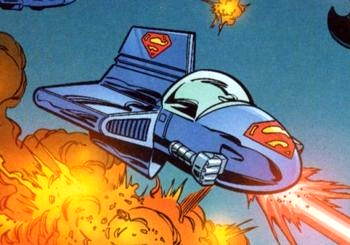
SUPERMOBILE
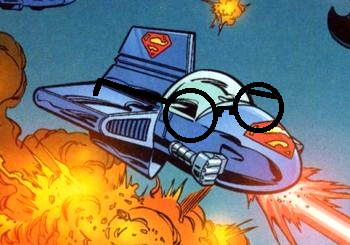
CLARK KENTMOBILE
Just grabbed the pic via the Googling, so hopefully I didn’t offend anyone with my repurposing his/her scan. It was for the purpose of creating a better world, my friend.
Anyway, in other news:
- Regarding that panel I posted yesterday…I felt a little funny picking out a panel by freakin’ Jerry Siegel and Joe Shuster, the creators of Superman, for a bit of good-natured mockery. I mean, it seems almost sacrilegious, doesn’t it? Anyway, that panel was from a strip called “Federal Men,” which ran for quite a while in the various iterations of early Adventure Comics. You can read descriptions of some of the stories here. A reprint collection of these stories would be interesting, but I’m not holding my breath.
By the way, speaking of sacrilege: here’s reader Todd with his slight reworking of the panel:
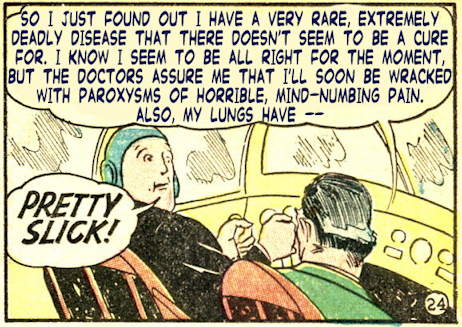
- Tom Spurgeon has some commentary from one of his readers about comic pricing and buying habits. In particular, there is some discussion about the likelihood of someone spending more than $20 a week on comics in the late 1980s. As someone who entered the high-finance world of funnybook retailing in the late ’80s, I thought I’d supply a brief bit of anecdotal…well, perhaps not “evidence,” but it may be of interest.
Starting about the mid-’80s, and off and on through the late ’80s, our shop had a box of overstock and/or deadstock comics by the register with a sign on it that read “FREE COMIC WITH $20 PURCHASE.” And, it is my memory that the $20 level was originally picked because 1) it wasn’t a price level that was normally breached terribly often by the majority of customers, but 2) it was close enough to what a significant portion of customers were spending that the hope was that they’d plop another comic or two on the pile to hit $20 and qualify for their free comic.
Now…and please consider, I’m working off decades-old memories here…I believe that we had some, but not a lot, of customers slapping on additional comics to get to twenty bucks, but that eventually we had enough people already buying twenty dollars’ worth of stuff without going back and grabbing an extra book or two that they got their free comic anyway. And, eventually still, sometime around the big Batman movie-fueled boom, we did away with it completely. (I suppose we could have just raised the price level to, say, $30 or $40 for the free book, but at the time rivers of cash were flowing through the direct market and thus, perhaps the need to encourage additional sales in that fashion was no longer as strong.)
Later, we briefly did a “spend $50, get a free poster” thing along these same lines, which I’m pretty sure was in the post-market crash years of the mid ’90s. And that tells me that, even though the high-livin’ days of the boom were long gone, the customer base that remained was spending far more on average than they had pre-boom, so that $50 now seemed like the just-above-average typical sales level that seemed achievable.
My memory was that was more about clearing out old poster stock than hoping people would hit $50, which, like what happened with the $20 level, is something people gradually started doing anyway.
Wish I remembered more details about these things. Should’ve kept better notes.
- Speaking of our retail past: Chris Sims recently concocted this Comics Alliance article about comic book bumper stickers, and in the comments section to it, someone mentioned our old “U.S. OUT OF LATVERIA” stickers that we had at the shop. [NOTE FOR MY DAD, WHO READS MY BLOG: Latveria is the fictional country that the Fantastic Four’s arch-nemesis, Dr. Doom, hails from.] Now, I tried to respond to said comment with a link to a post on my site featuring said sticker, but alas, the CA comment machine does not like linkity-links, so instead I’ll post that link here.
And before you ask: no, I don’t have any more. Sorry, kids.
- More Comico history: the transition to color printing, including some early and neat-looking coloring guides for a page from the original Mage series.
- Pal Dorian does terrible things to an old DC subscription pitch. TERRIBLE THINGS.
- Employee Aaron’s fiancée Kempo whips out her 2010 San Diego Comic-Con report, with lots of photos of the two of them eating meals.
- I’d noted something on my Twitter the other day, and thought I’d repeat it here: you know what I’d like to see Christopher Nolan name the third Batman movie? The Caped Crusader. That’d be pretty awesome, right? Yeah, I knew you’d agree.
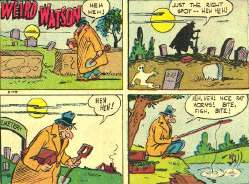
from Adventures into Darkness #14 (April 1954)
Someday I’d like to see a collection of all the space-filling short humor strips used to fill out comics back in the day. Also…was this Weird Watson’s only appearance? How can you
not love that guy?
What fresh hell is this? Weekly World News…shutting down? Bat Boy…homeless? Ed Anger…even angrier?
Weekly World News has had several connections to the comic book world, such as editors Paul Kupperburg and Bob Greenberger, writer Andy Mangels, and, of course, Peter Bagge’s run of initial “Bat Boy” comic strips, among others.
The supermarket just won’t be the same without Weekly World News staring back out at you at the checkout line. Another little piece of Americana slips away.
(First spotted via Metafilter.)
A couple more follow-up questions from the ’90s bust discussion:
- Commenter Phil asks
“One thing I’ve started wondering about your memories of the speculative boom – how much cash would your average collector buying multiple copies for investment value actually have sent down the toilet, in terms of purchase price versus current value?”
That’s a hard question to answer. Well, maybe not…the general response would be “a lot,” but it would depend really on what multiple copies they purchased (and assuming they kept them in sellable shape, which, as I noted Friday, was rarely the case).
But even if they did end up investing in a boom-era comic book with some current demand and a reasonable aftermarket price — say, for example, Spawn #1 — is the 30% to 50% (if you’re lucky) of that aftermarket price you’re going to get by selling it to a dealer, or on eBay, worth the fifteen years you’ve stored them? And if you have a lot of them, you might run into the problem I mentioned here…you might be able to sell 5 or 10 or even 20 copies of Spawn #1 to the same buyer, but it’s not likely you’ll be able to sell a full case of a couple hundred copies to that buyer. At least, not without taking an enormous loss on them. I can use some Spawn #1s for the shop, but I’m not going to tie up a lot of money in 200 copes that might take me a decade or more to sell. If you want me to buy a full case of Spawn #1, it better be cheap.
And if you’ve got something nobody wants, like, say, Brigade #1, you’ve gone from the “you may make a little bit of your money back” situation with Spawn to the “too bad it’s not soft enough to use as toilet paper” side of things. Sure, the price guide might say it’s worth cover price or so, but they’re not actually selling for that. To anyone. Ever. They’re not even selling in our bargain bins, much less at full price. Anyone who invested in Brigade will find themselves…well, I believe the technical term is “losing one’s ass.”
Speaking of asses and the loss thereof…another thing to consider, when it comes to value of many of the boom books…some of you folks may remember that our shop was clearing out some backstock, selling about 100,000 units to somebody who needed comic books in bulk, regardless of title or publisher. We unloaded tons of ’90s crash-era comics at the princely sum of one shiny nickel per funnybook. Alas, I doubt you’ll see that pricing reflected in the listings of your favorite price guide (“SECOND LIFE OF DR. MIRAGE #1 – $0.05 in NM condition”).
So, anyway, to actually answer the question: while I’m sure there are some success stories, the vast majority of people who invested in multiple copies probably only realized pennies for each dollar spent, if even that.
- Commenter Mathew has a question about something a little more recent:
“Do you think 52 would have sold as well if DC published it as a monthly trade rather than a weekly pamphlet?”
If they had gone the monthly paperback route, 52 would have been a drastically different creature. (For one, they would have called it 12.) It was designed as a weekly serial, with cliffhangers, and its impact (and novelty) would have been diminished had it been yet another monthly publication. Not saying there isn’t room for DC to experiment with a superhero story serialized as a monthly trade paperback, but 52 was primarily designed to take advantage of the weekly new comic pamphlet release schedule, which contributed to its sale success.
Another good sequence from Adventures into Darkness #14:
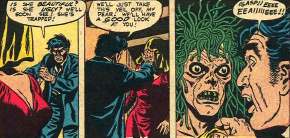
I don’t normally buy current publications from Archie Comics, and when I do, it’s almost always books that reprint their work from the ’60s and earlier. Such was the case with last week’s Archie Digest #236, which reprints Archie’s first appearance from Pep #22, along with a full reprinting of Archie #1 from 1942.
One of the stories from Archie #1 has Archie involved in a series of mix-ups on a train with another passenger, and the poor railroad porter gets caught in the shenanigans as well. The porter looks and talks like this:
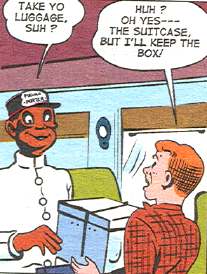
I realize it’s no shock to anyone familiar with comic book history that racist caricatures of black people (and Asians, and Native Americans, and so on) were common in early stories (and this isn’t even the worst example from this particular story, with other panels including dialogue like “I done thought…” and “Mus’ be dat bump on yo’ had!”). Not having an original
Archie #1 lying around the house, I’m going to assume the porter has been recolored slightly for the reprint, even though all his stereotypical dialogue appears to have remained intact.
I’m not saying this shouldn’t have been reprinted as is. If you’re going to reprint your old material for historical purposes, it should be reprinted as it was, warts and all*. And that’s what folks have been doing…a glance through your Shazam Archives and your Golden Age Wonder Woman Archives, among others, will show you examples of political incorrectness similar to that bit of business with the porter. But these are high end reprints, aimed at comic collectors, who are presumably familiar with the poor way minority groups were portrayed. Disclaimers aren’t uncommon, noting the usage of such caricatures were typical of the time, and left unchanged for historical reference.
This Archie digest, however, is aimed at a young, general audience. It’s one of the few modern comics actually sold in places where people who aren’t comic fans shop. At my grocery store, they’re right up there at the checkout line, next to the TV Guide and the Weekly World News. How will kids take the porter’s portrayal — how will the parents? — particularly since there is no disclaimer that I can find noting the historical reasons for that portrayal.
I’m very curious as to the response Archie Comics will receive.
Okay, one last round of “Mike Remembers Barely Making It Through the 1990s:”
- Commenter Stavner asks
“Do you think we’ll ever see comic books back in supermarkets and convenience stores?”
It’d be nice, and in some cases apparently you can find comics in some convenience stores…but a widespread revival of this manner of distribution? Not unless 1) comics get a whole lot more popular, and 2) the profit potential for them is enough for store owners to risk valuable space on them.
“Do you think Gemstone will keep publishing Disney comics for very long?”
Hard to say…my gut feeling says “no,” since their number of publications has declined, and their prices have gone up. Their last Don Rosa reprint book has sold very well for us, though, so maybe there’s some life there yet.
- H of the Comic Treadmill doth ask
“There are those who insist that monthly super-hero comics will be dead sooner rather than later. Do you see a trend in that department? What’s your take on the viability of our beloved monthlies?”
I think if the price point of the standard comic book goes much higher, something is going to have to give. My guess is a regular comic book will eventually undergo some form of evolution, possibly into a much thicker publication with more stories, at a slightly higher price point (but giving a higher perceived value to the reader), and just loaded with ads to help subsidize the cost of the magazine.
There are a lot of economic factors there that I’m overlooking (such as whether or not a comic book publication could attract enough ads, and get enough money from them). At the very least, I don’t think monthly books will go away, but they’ll have to become something new to give readers more perceived value for their money.
- Commenter Roel asks
“Where the hell did all these investors come from in the first place? I mean, why did everyone suddenly get the idea that these comics would be worth a lot of money? Comics had been around for decades and decades, and then — all of a sudden, out of nowhere — all these non-comic book fans start investing in them? Why? Was there some sort of triggering event? I don’t get it.”
Apparently there was a large crash in the sports card market just prior, and it was just a lateral shift from collecting one thing to another…I don’t have exact details, but it appeared to be common knowledge at the time. I can personally testify to the number of investor-types requesting “comic book Becketts” — Beckett being the publisher of several sports card price guides — so that lends credence to that theory.
Also, the greater awareness of comics among the general populace, driven by movies and media-hyped events, combined with a possible economic downturn and plenty of newspaper stories dragging out the old “did you know old comics are worth money?” thing…that made comics a large, attractive target for investing, without all that “dealing with brokers” stuff.
“Oh, another question — why are you so remorseful about selling pogs? How is that any worse than selling, say, a trading card or an action figure? People wanted pogs, and they wanted to give you money in order to own them. What’s the big crisis of conscience there?”
Because I can see the value of a trading card or an action figure. Though technically, I realize, there’s only a slight difference between a trading card and a POG, but least trading cards were numbered, sometimes had cardback text, and could be put into sets. They had something to them. POGs (or, rather, milkcaps) were, with some exceptions, just random pictures on bits of round cardboard, and just felt to me like it was worthless junk. The alleged “game” involving milkcaps was essentially jacks or marbles, without the skill….you threw a heavy disc down onto a pile of cardboard discs. and you kept the ones that turned over, or some damned thing.
I understand this might just be bias on my part, since there are plenty of folks who think comics are worthless junk too, but even if customers were willing to part with their money for POGs, I felt like I was giving them nothing of value in return. I was essentially turning their money into crap. I know I should feel like this when I sell someone a copy of, say, Purgatori, but I don’t.
Yeah, cheap shot at Purgatori, sorry, but I can accept that someone might find entertainment value in that comic. Somehow. I just don’t see that value in milkcaps.
* As far as story content goes, anyway…I realize the comics in question have been recolored and (it seems) relettered for clarity.
« Older Entries
Newer Entries »



 It seems really almost like yesterday I was setting up a table near the front of the store to show off all the editions of the brand-new X-Force #1, drawn by red-hot young artist Rob Liefeld. Each factory-sealed in polybags with one of five different trading cards, stacked up high and waiting for us to open our doors for that new comics day.
It seems really almost like yesterday I was setting up a table near the front of the store to show off all the editions of the brand-new X-Force #1, drawn by red-hot young artist Rob Liefeld. Each factory-sealed in polybags with one of five different trading cards, stacked up high and waiting for us to open our doors for that new comics day. 














